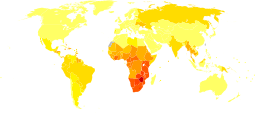Researchers have found that people who inject drugs could reduce their risk of HIV infection by nearly half if they take daily tablets of an antiretroviral drug called tenofovir disoproxil fumarate (tenofovir).
This was the first trial to evaluate whether preventative treatment with HIV drugs could prevent HIV infection among people who inject drugs.
Jonathan Mermin, M.D., director of CDC’s Division of HIV/AIDS Prevention said that this is a “significant step forward for HIV prevention. We now know that pre-exposure prophylaxis (PrEP) can work for all populations at increased risk for HIV.”
The findings, published in The Lancet, come from the Bangkok Tenofovir Study, conducted by the CDC (Center for Disease Control and Prevention) in collaboration with the Bangkok Metropolitan Administration and the Thailand Ministry of Public Health.
The investigation was led by Dr Kachit Choopanya.
A total of 2,411 men and women participated in the study from 17 drug treatment clinics in Thailand.
Close to half of the participants (1204) were given a daily dose of tenofovir while the rest (1209) were given placebo.
The participants received risk-reduction counseling as well as monthly HIV testing.
After an average follow-up period of four years, there were only 17 confirmed cases of HIV infection among people taking tenofovir, compared to 33 cases in the placebo group. This translates into a reduction in HIV risk of 48.9% for those on the daily dose of tenofovir.
Additional analyses of the results indicated that the protective effect of tenofovir was best in participants who adhered closely to the prescribing regime, reducing their risk of HIV transmission by 74 percent.
There have been other studies which showed that pre-exposure prophylaxis (PrEP) is effective in reducing the risk of contracting HIV. However, the protective effects of these antivirals have only been established among heterosexual couples and men who have sex with men and mother to child transmission – the drug is safe to use during pregnancy, according to a study published in PloS Medicine.
This study confirms that the approach also protects people who inject themselves with drugs.
Among drug users, sharing and reusing syringes contaminated with HIV-infected blood is extremely risky. Injecting drug use accounts for close to ten percent of new HIV infections worldwide. However, in eastern Europe and central Asia these rates are much higher, with 80 percent of HIV cases in these areas caused by injecting drugs.
According to Dr Martin:
“This study completes the picture of PrEP efficacy for all major HIV risk groups – we now know that pre-exposure prophylaxis can be a potentially vital option for HIV prevention in people at very high risk for infection, whether through sexual transmission or injecting drug use.”
Martin said that adherence was a very important factor in the trial. The finding underscores the importance of achieving effective levels of adherence among people using pre-exposure prophylaxis to prevent HIV.
However, Professor Salim Karim, Director of the Centre for the AIDS Program of Research in South Africa (CAPRISA), stated that people who use drugs often engage in other high risk behaviors such as selling sex to fund their addiction. He noted that the protective effect of tenofovir among drug users identified in this study could be attributed to the previously established positive effects of PrEP among those who engage in risky sexual behaviors.
Professor Karim concluded:
“Even though questions remain about the extent to which PrEP can be effective in preventing either of the routes of transmission in this group, the overall result is that daily tenofovir does reduce HIV transmission in injecting drug users.
The introduction of PrEP for HIV prevention in injecting drug users should be considered as an additional component to accompany other proven prevention strategies like needle exchange programmes, methadone programmes, promotion of safer sex and injecting practices, condoms, and HIV counselling and testing.”
Tenofovir gel has proven to guard against HIV infection during vaginal intercourse and also defends against the viral spreading of HIV during anal sex too, according to research presented at the 18th Conference on Retroviruses and Opportunistic Infections (CROI).
Researchers from the USA, Belgium and Italy reported in the journal Cell Host & Microbe that tenofovir, when formulated as a vaginal gel, was found to reduce herpes simplex risk in females.
In addition, when a partner in a couple has HIV and the other doesn’t, treatment with antiretroviral drugs can lower the risk of the infected partner passing along the disease to his or her mate, according to research published in The Cochrane Library.
Written by Joseph Nordqvist
